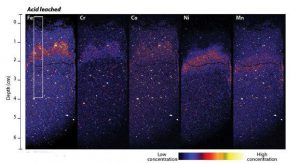Accelerated carbonation of mining waste may be used to recover cobalt, nickel
“If you can integrate carbon capture with the recovery of previously inaccessible minerals, say of nickel and cobalt, you could make some lower grade mines more viable,” said in a media statement Jessica Hamilton, lead author of the study and a researcher at the Australian Nuclear Science and Technology Organisation and Monash University. “According to a recent report in Science, today some 419 million tonnes of ultramafic and mafic (rich in magnesium and calcium) waste are produced annually with the potential, if fully carbonated, to lock up 175 million tonnes of atmospheric CO2 per year.”
To trial geochemical treatments to accelerate the carbonation of ultramafic mine tailings at ambient temperatures and pressures, Hamilton and her associates tried two different experiments.
The first one involved a direct reaction of partially saturated tailings from a derelict chrysotile (asbestos) mine in New South Wales with a simulated mining flue gas, containing 10% CO2 in dinitrogen.

This accelerated CO2 sequestration occurs by targeting a highly reactive mineral, brucite (Mg(OH)2), in the tailings.
In the second experiment, the investigators simulated a heap leaching treatment using laboratory columns.
“If we irrigate the mineral waste from mines with acid, the minerals dissolve to produce a solution that is rich in magnesium and calcium, which, in turn, react with CO2 and form solid carbonate minerals,” Hamilton said.
The investigation involved X-ray fluorescence microscopy or XFM at the Australian Synchrotron, which provided visual microscopic evidence of the distribution of trace metals and other key changes to the microstructure following leaching with diluted sulfuric acid.
The XFM revealed immobilized iron, chromium, cobalt, nickel and manganese at different depths in the column with the greatest concentration in the region where the pH of the acidic leaching solution was neutralized.
“The real power of XFM was that it allowed us to look at the distribution of elements at a really fine-scale and look at the coatings on grains, and the localized geochemical environments where metals were precipitating,” Hamilton said.
The heap leaching produced a liquid high in magnesium capable of sequestering an amount of carbon dioxide 200 times greater than the passive carbonation that occurred at the derelict mine.
“The choice of approach depends on the resources available at the mine and the local mineralogy,” the lead researcher said. “If there is waste acid available and you don’t have much active brucite, then heap leaching is a great option. If there is a CO2 source, and you have brucite, then you might go for a direct reaction with that gas. But the two can also be used together, for example, heap leaching can be followed by reaction of the magnesium-rich fluids with a CO2source.”
An added benefit is that for mines or mineral processing that produces acid as a by-product, this acid can be used and neutralized.
According to the scientists involved in this project, the approach is suitable for waste from platinum, chromite, diamond, some nickel, copper, and historical chrysotile mines.




